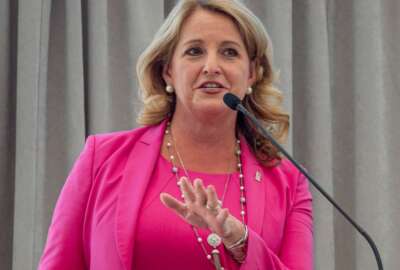
Agencies are launching new reskilling, IT career opportunities in all shapes and sizes
USDA is the latest agency to announce a new training and reskilling opportunity, this time geared for rising IT employees interested in becoming a CIO or CISO.
Best listening experience is on Chrome, Firefox or Safari. Subscribe to Federal Drive’s daily audio interviews on Apple Podcasts or PodcastOne.
When it comes to reskilling and training their employees for future IT opportunities, agencies are beginning to learn one size truly does not fit all.
It’s why the Trump administration is engaged in several pilots designed to provide new career opportunities in IT for federal employees at all levels.
“We’re all talking to each other. There are many different programs going on, and they’re not the same. They’re trying to attack this issue from many different angles at once,” Dorothy Aronson, chief information officer at the National Science Foundation and co-chair of the Federal CIO Council workforce committee, said Wednesday at FCW’s cybersecurity summit in Washington. “There’s not just one solution. It’s not as if we expect to have a one-size-solution in the end.”
The Agriculture Department, for example, this week announced a new Senior Executive Service candidate development for up-and-coming IT leaders. The program is open to GS-14s and 15s at all agencies who have at least one year of supervisory experience.
The program is designed to groom the next generation of chief information officers and chief information security officers, according to the USAJOBS.gov announcement on opportunity.
Candidates who are selected will receive formal training, assessments and seminars, which will be funded by the CIO Council. Program candidates must have an SES mentor and complete one executive-level developmental assignment for at least four months.
Participants who complete the program will submit a portfolio to the CIO/CISO Executive Resources Board for approval, according to the job announcement.
Surveying data science, analysis skills
A relatively traditional SES candidate development program seems right for rising IT executives, but for employees who have limited IT experience, the path to a new career opportunity looks much different.
Related Stories

Federal CIO Kent: AI pushes need to retrain ‘broader swath’ of federal employees
Employees’ skills gaps in the field, however, might be wider than NSF initially thought.
“We surveyed a group of people to see who was interested in using Udacity, and we found out that even the basic data science skills aren’t prevalent,” Aronson told Federal News Network. “What we learned was a lot of people were very interested in participating in the Udacity experiment, but they didn’t have the basic skills to enter into the data analyst or data scientist program.”
Based on that feedback, NSF will survey employees interested in data science to learn more about their skills gaps.
“It’s possible that people will need basic logic training,” Aronson said. “I have no idea what the breadth of the need is going to be. We’re hoping to team people up to look across the federal government to find where various training opportunities are and leverage the existing training tools. But we want to meet people where they are instead of requiring them to be at a certain level before they begin.”
For other employees at USDA, new career opportunities are coming as the department continues its IT transformation through the Centers of Excellence and other initiatives.
When the Office of the Financial Officer began to use robotic process automation (RPA) to handle disbursements, USDA realized it needed to more fully evaluate the impacts the new technology would have on its employees.
“The individuals who are probably doing disbursements in that area may have been with the organization for a long time, probably have some old skills and used to work in our mainframes,” said Venice Goodwine, chief information security officer for cybersecurity at USDA. “If I then automate that process what is that individual going to do? Their skill set is probably not current for what we need to do today. I have to have a plan for that. We always forget about the workforce and the people portion of technology.”
The department studied the impact RPA would have on full-time equivalents and man-hours and established a specific governance plan to describe the effects of automation on its workforce, she said.
USDA is using National Initiative for Cybersecurity Education (NICE) codes to map reskilling plans for impacted employees, Goodwine said.
USDA will use that governance plan to guide future emerging technology pilots and workforce reskilling efforts, she added.
Meanwhile, other governmentwide skilling initiatives are also evolving.
The first cohort of non-IT professionals graduated from the Federal Cybersecurity Reskilling Academy graduated last month. Training courses are underway for the second cohort.
In addition, NSF is nearing the end of the Career Compass Challenge, which it launched last November. The agency solicited proposals that NSF — and eventually all of government — can use to match federal employees to future career paths.
NSF received about a dozen prototypes, most of which made it to the second round of judging. The agency will announce the winning proposal some time in late August.
The challenge is also meant to start a broader conversation about reskilling, which Aronson acknowledged can seem daunting.
“To some degree, it’s the words that make people nervous,” she said. “They know that they need to make decisions based on data. If we can give them ways of getting to that data without using scary words or tools… then we will in fact launch the new generation of people into the workforce where IT is more prevalent.”
Copyright © 2024 Federal News Network. All rights reserved. This website is not intended for users located within the European Economic Area.
Nicole Ogrysko is a reporter for Federal News Network focusing on the federal workforce and federal pay and benefits.
Follow @nogryskoWFED




